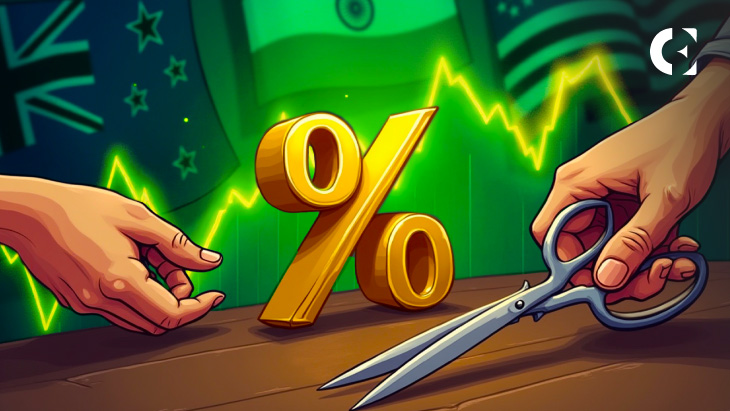- India’s central bank cuts the interest rate to 6% amid growth and inflation risks.
- New Zealand lowered its rate to 3.5% to counter slowing demand and global pressures.
- Lower rates increase liquidity and push investors toward riskier assets like Bitcoin.
India and New Zealand each announced 25 basis point cuts to their key interest rates this week. Central banks of both the countries made the move aiming to stimulate economic growth as ongoing global trade tensions and demand continue to pressure their economies.
These decisions respond to slowing growth, potential inflation risks, and global economic friction that have created uncertainty in financial markets worldwide.
India’s Rate Cut Addresses Growth Headwinds
The Reserve Bank of India (RBI) reduced its key interest rate to 6% from 6.25%. This move supports the economy, which has been facing headwinds from slower growth and inflation.
Economists widely anticipated this rate cut, forecasting a 25 basis point reduction. Some market observers, however, had hoped for a stronger signal, speculating the RBI might shift its policy stance to “accommodative” to provide more economic support.
Related: Billionaire Investor Ray Dalio Warns that Tariffs are Only the Beginning
New Zealand Follows Suit Citing Slowdown
Meanwhile, New Zealand’s central bank also announced a 25 basis point reduction in its official cash rate, bringing it down to 3.5%. The Reserve Bank of New Zealand (RBNZ) pointed to slowing domestic growth and weaker-than-expected inflation as key reasons for its decision.
As the global economic environment remains uncertain, the New Zealand central bank is positioning itself to support economic recovery by lowering borrowing costs, which is expected to encourage consumer spending and investment.
Related: Engineered Recession Response? Theory Swirls as Tariffs Send Markets Reeling
What Rate Cuts Mean for the Crypto Market
These recent interest rate cuts could potentially send mixed signals to the crypto market. Generally, lower rates increase liquidity in the financial system and can push investors toward riskier assets like Bitcoin, potentially boosting prices.
Rate cuts driven by economic weakness, however, can also trigger volatility. Increased capital might flow into crypto seeking yield, but this could lead to short-term gains followed by sharp corrections if underlying economic fears persist.
Interest rates are just one piece of the puzzle; regulation and broader global trends also heavily influence crypto price movements.
Disclaimer: The information presented in this article is for informational and educational purposes only. The article does not constitute financial advice or advice of any kind. Coin Edition is not responsible for any losses incurred as a result of the utilization of content, products, or services mentioned. Readers are advised to exercise caution before taking any action related to the company.







